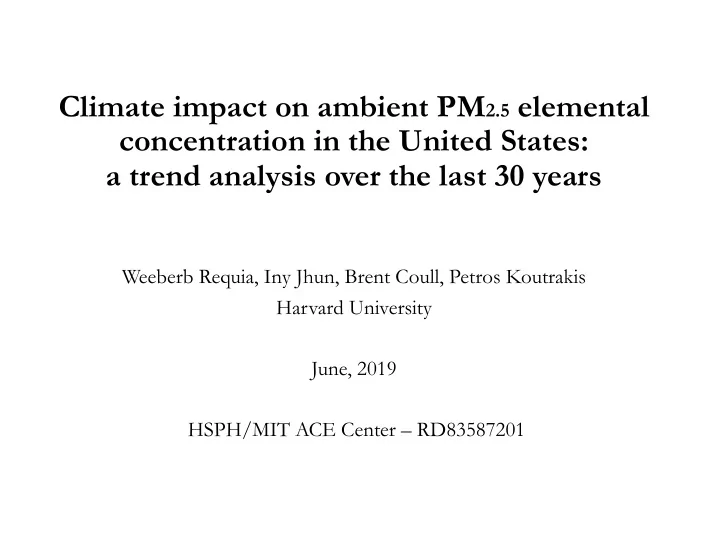

Climate impact on ambient PM 2.5 elemental concentration in the United States: a trend analysis over the last 30 years Weeberb Requia, Iny Jhun, Brent Coull, Petros Koutrakis Harvard University June, 2019 HSPH/MIT ACE Center – RD83587201
Back Background und • Weather impacts on the chemical composition of PM 2.5 varies significantly over space and time • Diversity of particle components and the complex mechanisms governing particle formation and removal Temperature
Ob Obje jectives • We quantified the impacts of climate change on ambient PM 2.5 composition and levels in the US. • Specifically, we performed a trend analysis based on a large temporal datasets of PM 2.5 species concentrations and weather over the last 30 years.
Ai Air q quality a and w weather d data c col ollection on • We evaluated the impacts of weather changes on seven major components of ambient PM 2.5 , including elemental carbon (EC), organic carbon (OC), nitrate, sulfate, sodium (Na + ), ammonium, and silicon. • Daily air pollution data for the period 1988 and 2017 were obtained from the US Environmental Protection Agency (EPA) • Meteorological data were provided by the National Oceanic Atmospheric Administration’s National Climatic Data Center (NOAA) • temperature • wind speed • relative humidity
St Statistical a analysis • Step 1: • Past weather changes in ground-level temperature, wind speed, and relative humidity General linear regression model • Step 2: • Weather-related increases in air pollution GAM models Analyses were stratified by season (warm and cold) and regions Warm season (May – October); Cold season (November – April)
Based on the National Mortality Air Pollution Study by HEI
St Statistical ana nalysis (step 2: Weather-related increases in air pollution) § Adjusted model: Y = α + β !"#$%&'" %&'( + γ month + σ weekdays + s ( temp + s ) ws + s * rh + e § Unadjusted model: Y = α + β $+!"#$%&'" %&'( + γ month + σ weekdays + e • While the weather impact is incorporated into the unadjusted trends, the adjustment with weather variables in model 1 removes the impact of inter-annual weather variation on air pollution trends. • We considered that any differences between the unadjusted and weather-adjusted trends are entirely attributable to the impact of long-term weather changes.
St Statistical ana nalysis (step 2: Weather-related increases in air pollution) β !"#$%&'" and β $(!"#$%&'" values to quantify past weather-related increases “Weather penalties” β $(!"#$%&'" − β !"#$%&'" A positive penalty ( β $(!"#$%&'" > β !"#$%&'" ) suggests that an increase in species p of PM 2.5 is associated with long-term weather changes in 1988-2017.
St Statistical ana nalysis (step 2: Weather-related increases in air pollution) Adjusted • Bootstrap analysis to estimate standard error Unadjusted Penalties • Meta-analysis.
Re Results (w (weath ther tr trends) ) • Temperature increased in four regions: • Industrial Midwest (IM) and North East (NE) during the warm and cold season • Upper Midwest (UM) and West (W) only in the cold season. • NE was the region with the highest increases in the study period (1988-2017). • annual increase of 0.036 ºC (95% CI: 0.035; 0.037) during the warm season • annual increase of 0.031 ºC (95% CI: 0.030; 0.032) during cold season • Wind speed decreased in all regions (both warm and cold seasons), except in the SW region during the cold season. • Trends of relative humidity varied significantly by season and region • During the warm season, relative humidity increased in most regions. Only the West Coast regions (NW and W) exhibited decreases in relative humidity.
Spatial distribution of weather penalties for each ch speci cies of PM 2. 2.5 , r , region ( n (and na nd nationa nal meta-an me analy alysis is), an and seas ason in in 1988 – 2017 2017 Note: unit of the scale of the bar charts (µg/m 3 ).
Results Re (Tot otal al weath ther penalty alty betw tween 1988 an and 2017) Warm season Cold season • EC: 0.036 µg/m 3 (95%CI: 0.032 ; 0.039) • EC: 0.037 µg/m 3 (95%CI: 0.019 ; 0.055) • OC: 0.21 µg/m 3 (95%CI: 0.15 ; 0.24) • OC: 0.19 µg/m 3 (95%CI: 0.16; 0.22) • Nitrate: 0.039 µg/m 3 (95%CI: 0.001; 0.08) • Nitrate: 0.056 µg/m 3 (95%CI: 0.048 ; 0.064 ) • Sulfate: 0.35 µg/m 3 (95%CI: 0.20; 0.47) • Sulfate: 0.04 µg/m 3 (95%CI: 0.003 ; 0.06) • Sodium: -0.014 µg/m 3 (95%CI:-0.017;-0.010 ) • Sodium: -0.011 µg/m 3 (95%CI: -0.004;-0.017 ) • Ammonium: 0.074 µg/m 3 (95%CI:0.04; 0.19 ) • Ammonium: -0.024 µg/m 3 (95%CI:-0.017;-0.066) • Silicon: 0.026 µg/m 3 (95%CI: 0.023 ; 0.028 ) • Silicon: 0.020 µg/m 3 (95%CI: 0.012 ; 0.028)
Co Conclusio nclusions ns • Ambient PM 2.5 components are strongly linked to weather variables such as temperature, relative humidity, and wind conditions. • Our findings suggest that weather changes over the last 30 years increased the ambient concentration of most PM 2.5 components in the US.
Recommend
More recommend